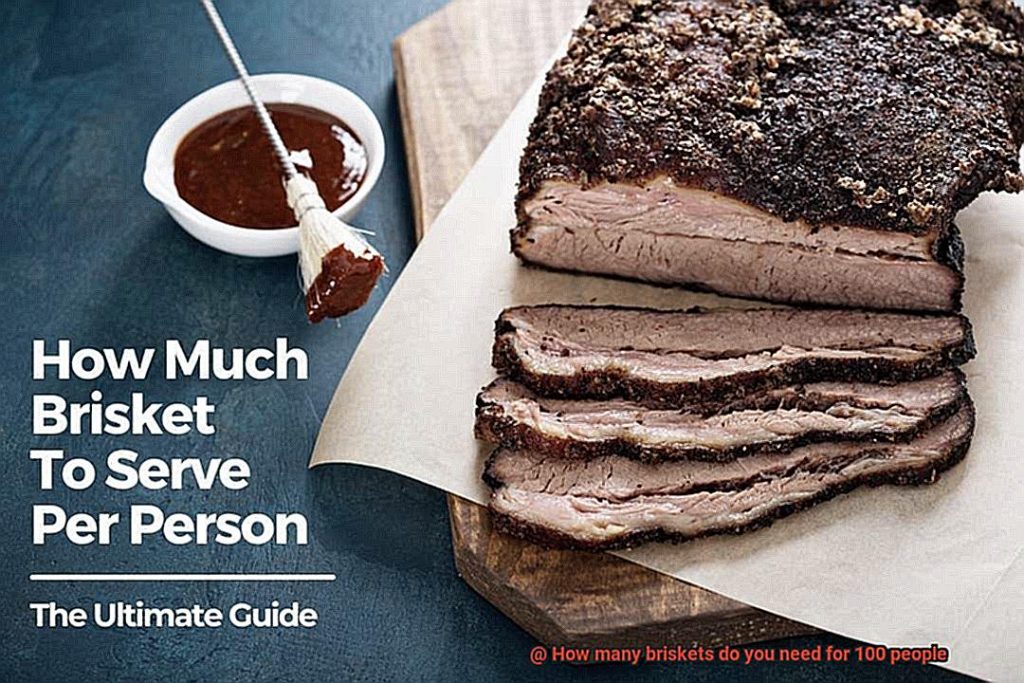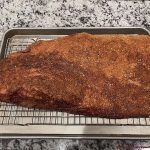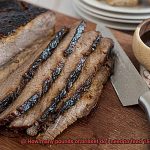Are you gearing up for a backyard BBQ or hosting a big family gathering? If so, the question of how much food to prepare can be daunting. You don’t want to run out of grub or end up with a ton of waste. Fear not. We’re here to help you tackle the burning question of how many briskets you need for 100 people.
Let’s start with the basics. Brisket is a mouthwatering cut of beef that’s perfect for smoking or slow-cooking on the grill. It’s versatile and can be served in various ways, making it an excellent option for feeding a crowd. But just how much do you need?
The answer depends on several factors, including serving size, side dishes, and your guests’ appetites. Typically, an 8-10 pound brisket can feed around 12-14 people. So for a group of 100 hungry folks, you’ll need about 8-10 briskets. But wait, there’s more. Keep in mind that some guests will go back for seconds while others may have smaller appetites.
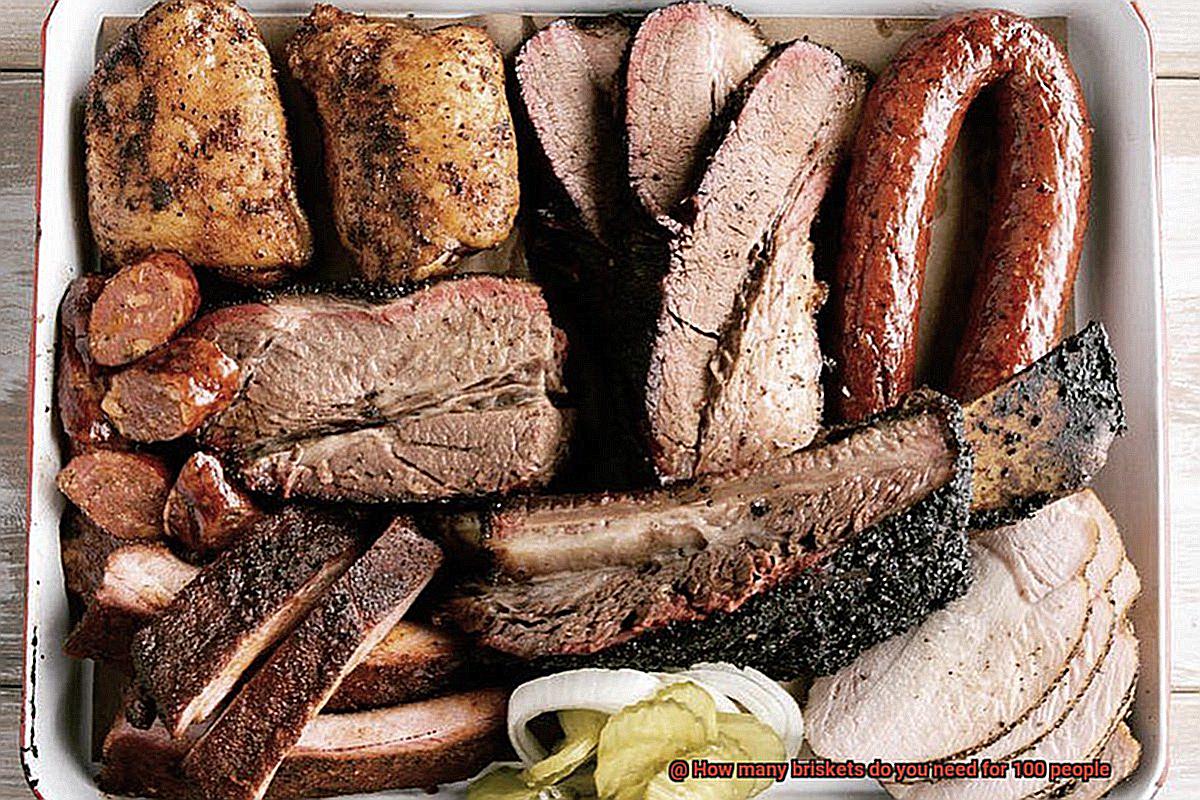
Don’t fret if this estimate seems too high or low for your event – we’ve got alternative methods to help you determine the perfect amount of brisket to prepare. Stick around as we dive into the best approaches to planning your next brisket feast.
Contents
Factors to Consider when Determining How Many Briskets are Needed
Planning a BBQ or grilling party for 100 people can be daunting, especially when determining how much brisket is needed. However, by considering several factors, you can ensure that everyone is well-fed and satisfied.
The weight of the brisket is the first factor to consider. Briskets come in different sizes, so it’s crucial to know the weight of each brisket being used. A general rule of thumb is that each pound of brisket will serve two people. Therefore, a 10-pound brisket will serve 20 people.
Serving size is another crucial factor to keep in mind. Not all guests have the same appetite, and some may eat more than others. It’s essential to account for individuals who may be bigger eaters or have a larger appetite. Additionally, if brisket is the main attraction, it’s best to have a little extra on hand to ensure everyone gets their fill.
The cooking method and temperature also play a role in determining how many briskets are needed. If the brisket is being cooked low and slow, it will shrink more than if it were cooked at a higher temperature. This means that more briskets may be needed to feed 100 people if they are being cooked at a lower temperature.
It’s also important to keep in mind that not all guests will eat beef. Providing alternative food options such as chicken or vegetarian options will ensure that everyone has something to eat. Sides such as potato salad, coleslaw, or baked beans can supplement the meat and provide variety.
Lastly, it’s crucial to consider the occasion and the guests’ preferences. If this is a casual backyard barbecue with mostly meat-eating guests, more brisket may be needed than if it were a formal event with dietary restrictions and preferences. Therefore, getting an idea of what types of food guests prefer before determining how much brisket is needed is always beneficial.
Weight of the Brisket
It may seem like a minor detail, but it can make all the difference in how many briskets you need to purchase to feed 100 hungry guests.
Let’s dive into the juicy details, shall we? Typically, a brisket weighs between 8-12 pounds, with some larger ones reaching up to 16 pounds. But how does this affect how many briskets you need for your event?
Well, first things first – determine how much meat per person you want to serve. A standard portion size of meat is about 6-8 ounces. Therefore, for 100 people, you’ll need a total of 600-800 ounces of meat.
Now, let’s factor in the weight of the brisket. For example, if you’re using 10-pound briskets, after trimming and cooking, you’ll end up with roughly 6 pounds of meat per brisket. This means that one brisket will yield approximately 96 ounces of meat.
To serve 100 people with a standard serving size of 6-8 ounces each, you’ll need around 75-100 ounces of meat per person. So, to satisfy your guests’ appetites, you’ll need approximately 8-10 briskets.
But keep in mind that these calculations are just estimates and can vary depending on factors like appetite and other sides being served. Nonetheless, using the weight of the brisket as a starting point can give you a better idea of how much meat you’ll need for your event.
Serving Size per Person
If you’re planning a gathering and wondering how much brisket to serve per person, there are several factors to consider. As an expert in serving size per person, I’m here to help you navigate through the details and create an unforgettable culinary experience for your guests.
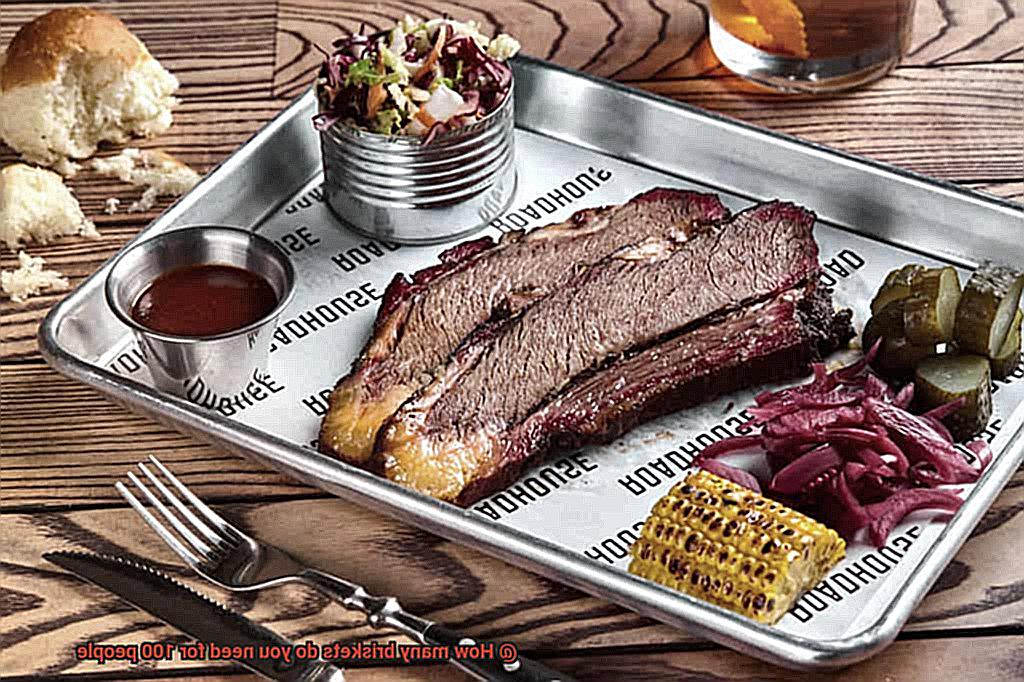
First and foremost, let’s talk about the weight of the brisket. On average, a brisket weighs around 12-14 pounds. That means for 100 people, you would need roughly 12-14 briskets. However, keep in mind that not everyone has the same appetite. Some may eat more than others, while some may not eat any meat at all. It’s always better to have a little extra meat available to ensure that everyone is satisfied.
The type of event you’re hosting is another crucial factor to consider when determining serving size per person. For a casual backyard barbecue, guests may be more likely to indulge in larger portions. But if it’s a formal event with multiple courses, guests may prefer smaller portions to save room for other dishes. Adjust your serving size accordingly to match the occasion.
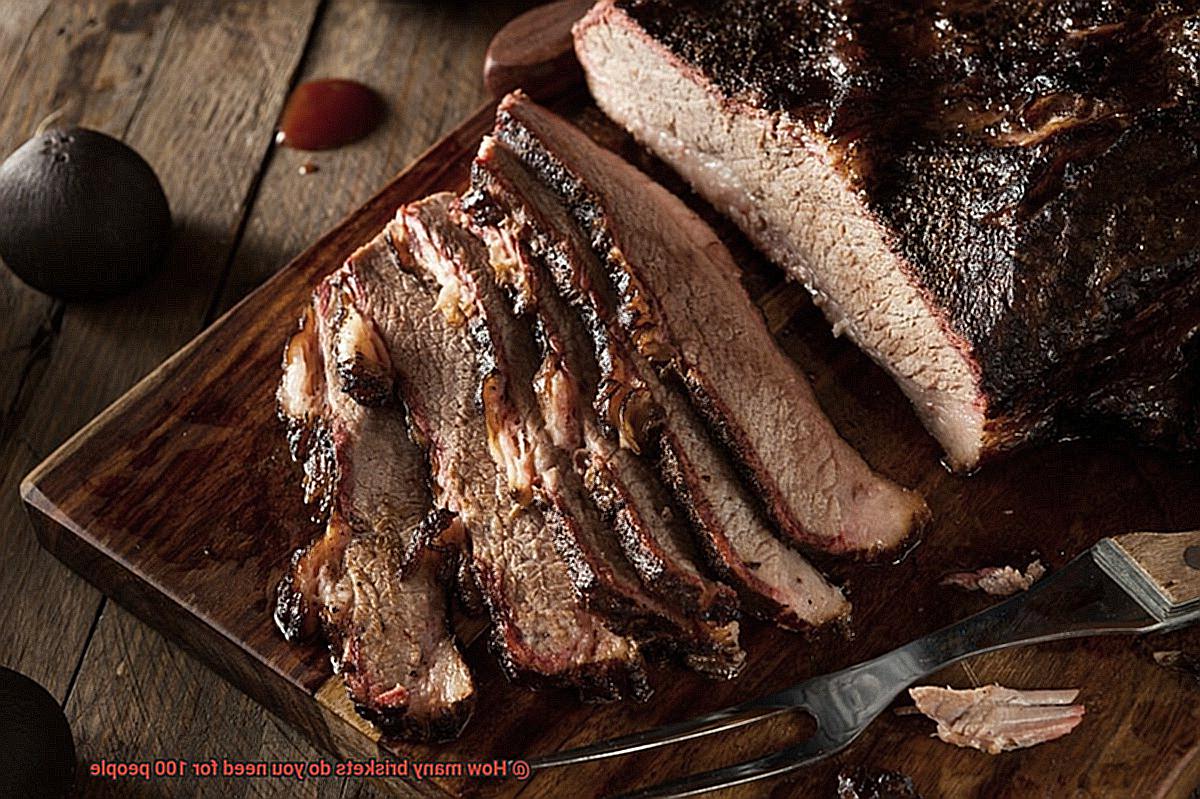
It’s also important to provide options for guests who have dietary restrictions or preferences. Consider having a vegetarian or vegan option available, as well as sides and salads that can accommodate different dietary needs. This will ensure that all guests feel included and well-fed.
Appetite of Guests
As you prepare to serve brisket to a crowd of 100 people, it’s important to factor in the appetite of your guests. Knowing their eating habits will help you estimate the amount of meat per person needed for a successful event.
To begin with, you need to consider if your guests are hearty eaters or if they prefer smaller portions. A standard serving of brisket is around 4-6 ounces. But if your guests are known for having larger appetites, consider planning for closer to 6-8 ounces per serving. Conversely, for lighter eaters or events where other dishes will be served, plan on 3-4 ounces per serving.
Moreover, the type of event you’re hosting can also affect how much brisket is needed. For instance, a casual backyard barbecue may lead to larger portions while a formal sit-down dinner with multiple courses may result in smaller portions.
As you plan your menu, don’t forget to account for the unexpected. It’s always a good idea to have extra meat just in case unexpected guests show up or someone wants seconds. A helpful rule of thumb is to plan for one pound of brisket per person. This will provide around 16-18 servings per brisket.
Alternative Food Options
When it comes to feeding a crowd, it’s important to cater to everyone’s tastes and dietary restrictions. Offering alternative food options ensures that everyone has something to eat and feels included. As an expert on alternative food options, I’ve compiled a list of delicious and crowd-pleasing choices that will leave your guests feeling satisfied and happy.
First up on the list is pulled pork. This tender and flavorful meat is a great alternative to brisket and can be served with a variety of toppings such as barbecue sauce, coleslaw, and pickles. It’s easy to make in large quantities, making it a perfect choice for feeding a crowd.
Next, we have grilled chicken. This lean protein can be marinated in a variety of flavors and served with different sauces or seasonings. It’s a healthier option for those who may be watching their calorie intake but still want a delicious main dish.
Vegetarian and vegan options are also essential when catering to a crowd. Grilled vegetables such as bell peppers, zucchini, and eggplant can be seasoned with herbs and spices for a flavorful dish. Bean burgers or veggie burgers are also great options for those who don’t eat meat. These options are not only tasty but also provide a good source of protein for vegetarians and vegans.
Don’t forget about side dishes and appetizers. A salad bar with various toppings, fruit platters, and vegetable trays can provide healthy options for those who prefer lighter fare. Gluten-free and dairy-free options should also be available for those with specific dietary restrictions.
Moreover, there are plenty of other alternative food options that you can consider. Here are some more ideas:
- Tofu stir fry: A tasty vegetarian option that’s packed with protein.
- Fish tacos: A flavorful fish alternative that’s perfect for summer gatherings.
- Falafel: A Middle Eastern classic that’s perfect for vegans.
Supplementing the Meat with Sides
As a host, you want to make sure that your guests have a memorable experience at your event. To achieve this, it is crucial to consider the sides that will accompany the meat, especially when cooking brisket for a large group of people. Failure to plan adequately can result in either too much or too little meat being cooked, leading to an unsatisfied crowd.
One way to ensure that everyone has enough food is by supplementing the meat with a variety of sides. Traditional barbecue sides such as coleslaw, potato salad, baked beans, mac and cheese, and cornbread are all excellent options that can be prepared in large quantities to feed a crowd. These sides are easy to make and will provide guests with various alternatives to choose from.
When determining the quantity of each side dish to make, plan for 1/4 to 1/2 cup per person. For instance, for 100 people, prepare approximately 25-50 cups of each side dish. However, since guests have different appetites, prepare more than you think you’ll need just in case.
It is also essential to consider dietary restrictions when supplementing the meat with sides. Be sure to offer vegetarian and gluten-free options so that everyone can enjoy the meal. Grilled vegetables or a simple green salad are excellent options for vegetarians, while gluten-free guests can enjoy sides like fruit salad or quinoa salad.
In addition to the food itself, presentation is key. A well-presented spread of food will not only look appetizing but will also encourage guests to try different sides they may not have considered before. Use colorful plates and serving dishes or add fresh herbs or garnishes for an extra pop of flavor.
Cooking Method for Brisket
Brisket is a tantalizing cut of meat that can be cooked in a variety of ways, each with its own distinct flavor and texture. As an expert on cooking methods for brisket, I’m excited to share some tips and tricks that will help you create the perfect brisket for your next event.
One of the most popular methods for cooking brisket is smoking. This involves slow-cooking the meat over low heat for several hours, typically with wood chips or chunks added to enhance the flavor. Smoking adds a rich, smoky flavor to the meat and creates a tender, juicy texture that will have your taste buds dancing. Whether you’re using a smoker box or a pellet smoker, smoking your brisket is sure to impress your guests.
Another fantastic method is braising. This involves cooking the meat in a liquid, such as broth or wine, over low heat for several hours until it becomes tender and flavorful. Braising can be done in a Dutch oven or slow cooker and is an excellent option for those who don’t have access to a smoker or grill. Adding vegetables like onions, carrots, and celery to the braising liquid will add even more depth and complexity to your brisket.
Finally, some people prefer to cook their brisket on the grill. This involves searing the meat over high heat to create a crust and then cooking it over low heat until it reaches the desired internal temperature. Grilling can create a beautiful charred exterior that will make your mouth water. If you’re grilling your brisket, be sure to keep an eye on it to prevent burning and adjust the heat as needed.
Reheating Tips for Perfectly Tender and Juicy Brisket
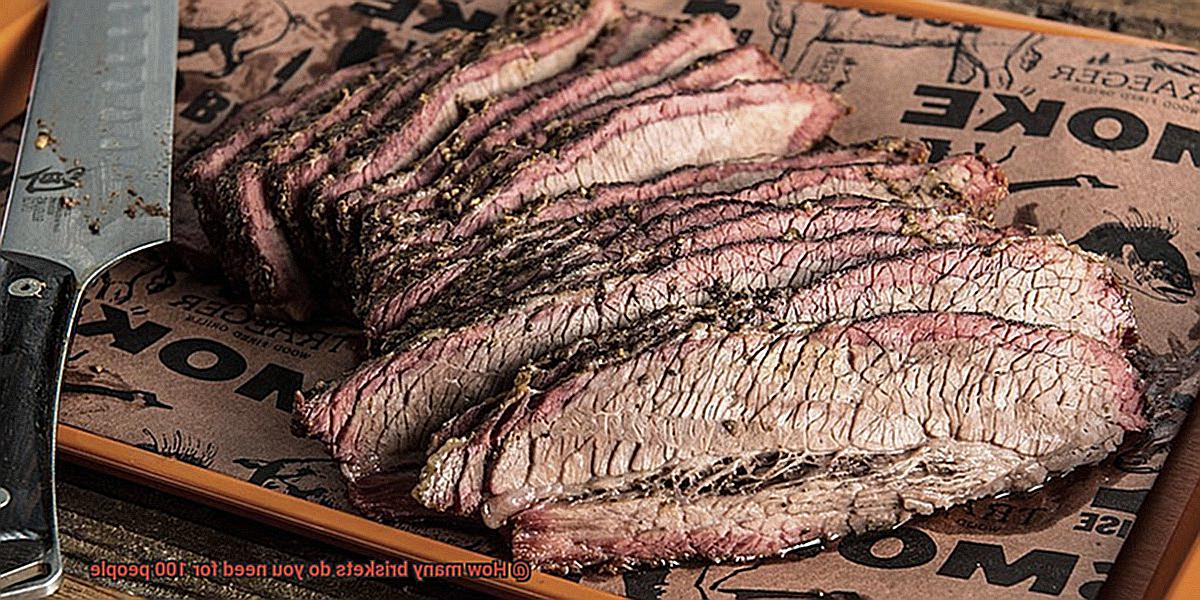
Brisket is a delicious and flavorful meat that can be enjoyed even after it has been cooked. However, reheating it improperly can lead to dry and tough meat, which can ruin the taste and texture. To ensure that the brisket remains tender and juicy, it is crucial to reheat it slowly at a low temperature. This way, the meat will retain its moisture and tenderness.
Reheating Brisket in the Oven
Using an oven to reheat brisket is a popular method that many people prefer. To do this, preheat the oven to 250°F and wrap the brisket tightly in foil. Place it on a baking sheet and heat for around 30 minutes per pound of meat. This slow heating process will help keep the meat moist and tender, ensuring perfect results every time.
Reheating Brisket on a Grill
Reheating brisket on a grill is an excellent option for those who love a smoky flavor. Heat up the grill to 250°F and wrap the brisket in foil. Place it on the grill and cook for around 30 minutes per pound of meat. This method gives the meat a smoky flavor that many people enjoy, making it a perfect choice for outdoor gatherings or BBQ parties.
Avoid Overcooking During Initial Cook
To prevent dry and tough meat when reheating, it’s essential not to overcook the brisket during its initial cook. Overcooking can lead to moisture loss, making it challenging to reheat later on. Therefore, it’s essential to monitor the cooking process closely and ensure that you remove the brisket from heat once it has reached the desired level of doneness.
Storing Leftover Brisket
When storing leftover brisket, it’s crucial to keep it fresh and flavorful. To do this, store it in airtight containers or wrap it tightly in foil to prevent air exposure, which can cause it to dry out. You can store leftover brisket in the refrigerator for up to four days or freeze it for up to three months. When ready to reheat, follow one of the methods outlined above for perfectly tender and juicy results.
XgBWgf-VpGk” >
Conclusion
In conclusion, the task of determining how many briskets to serve for 100 people may seem daunting, but fear not. With a few key factors in mind, you can easily plan the perfect amount of meat for your event. The weight of the brisket is a crucial starting point, as each pound can typically serve around two people. However, don’t forget to consider serving size per person and your guests’ appetites as well.
To truly wow your guests, consider offering alternative food options like vegetarian or vegan dishes and supplementing your meat with delicious sides like coleslaw or baked beans. And if you really want to take your brisket to the next level, try experimenting with different cooking methods like smoking or braising. These techniques can add depth and complexity to your meat that will have everyone coming back for seconds (and thirds.).
Finally, don’t forget about reheating tips. Slow heating at a low temperature is key to keeping your leftovers tender and juicy.
Overall, by taking all of these factors into account and following the tips outlined in this article, you’ll be well on your way to hosting a successful event with mouthwatering brisket that will leave everyone feeling satisfied and happy.

